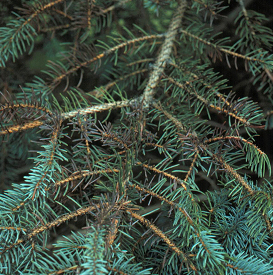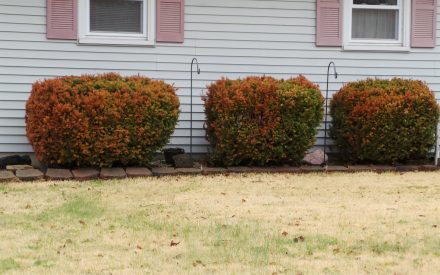
What is Rhizosphaera needle cast?
Rhizosphaera needle cast is the most common disease of Colorado blue spruce in Wisconsin, making Colorado blue spruce unsightly and unusable in many landscape settings. The disease also affects other conifers including black, Engelmann, Serbian, Sitka, and white (e.g., Black Hills) spruce; Austrian, mugo and eastern white pine; Douglas-fir, balsam fir and western hemlock.
What does Rhizosphaera needle cast look like?
The first noticeable symptom of Rhizosphaera needle cast is purpling or browning and loss of the innermost needles on lower branches of spruce trees. Often, the youngest needles at the tips of branches remain healthy. Rows of small, black spheres form along the length of infected needles and are visible with a 10X hand lens. These black spheres are fruiting bodies (i.e., reproductive structures) of the fungus that causes the disease and are diagnostic.
Where does Rhizosphaera needle cast come from?
Rhizosphaera needle cast is typically caused by the fungus Rhizosphaera kalkhoffii, although other species of Rhizosphaera can be involved depending on the host. Infected needles, including those that are still attached to branches and those that have fallen to the ground, produce spores that can be blown or splashed to healthy needles.
How do I save a tree or shrub with Rhizosphaera needle cast?
Consider treating affected trees with fungicides labeled for use on evergreens and containing copper or chlorothalonil. Treatments will not cure existing infections, but can prevent additional infections. Apply treatments every three to four weeks starting as new needles emerge each spring. Continue applications through periods of wet weather. For fungicide treatments to be effective, thoroughly cover all needles. This may be difficult on large trees. Be sure to read and follow all label instructions of the fungicide that you select to ensure that you use the product in the safest and most effective manner possible.
How do I avoid problems with Rhizosphaera needle cast in the future?
The easiest way to avoid Rhizosphaera needle cast is to avoid planting Colorado blue spruce. If you do plant this tree, consider using dwarf varieties, and allow adequate spacing between trees so that branches will not overlap when they are full size. Dwarf varieties and properly spaced larger spruce varieties will have better air penetration and needles will dry more quickly. Dry needles are less likely to be infected. Check existing spruce trees for the disease, and remove and destroy any diseased branches and needles by burning (where allowed by local ordinance), burying or hot composting.
For more information on Rhizosphaera needle cast:
Contact the University of Wisconsin Plant Disease Diagnostics Clinic (PDDC) at (608) 262-2863 or pddc@wisc.edu.
Authors: Brian Hudelson, UW-Madison Plant Pathology
Last Revised: 03/01/2024
D-number: D0093
References to pesticide products in this publication are for your convenience and are not an endorsement or criticism of one product over similar products. You are responsible for using pesticides according to the manufacturer’s current label directions. Follow directions exactly to protect the environment and people from pesticide exposure. Failure to do so violates the law.
Thanks to Diana Alfuth, Jean Ferdinandsen, Lisa Johnson, Scott Reuss and Amy Sausen for reviewing this document.
A complete inventory of UW Plant Disease Facts is available at the University of Wisconsin-Madison Plant Disease Diagnostics Clinic website: https://pddc.wisc.edu.
Send a Plant Sample for Analysis
Be cautious when self-diagnosing plant health issues. Very few diseases can accurately be diagnosed by eye.
Contact the UW Plant Disease Diagnostics Clinic (PDDC), and for a small fee, clinic staff can examine a plant, determine the cause of the disease/disorder, and provide advice on how to control or prevent the issue.
Download Article





 Swiss Needle Cast
Swiss Needle Cast Weir's Cushion Rust of Spruces
Weir's Cushion Rust of Spruces Dothistroma Needle Blight
Dothistroma Needle Blight Winter Burn
Winter Burn


